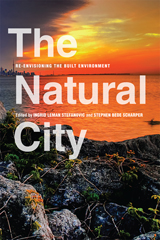The Natural City: Re-envisioning the Built Environment

In 1950, only 30 per cent of the population lived in urban areas. Today, more than half do and by 2030, the United Nations predicts 60 per cent of the world’s populations will live in cities. The Natural City: Re-envisioning the Built Environment explored the social and ecological implications of this massive and rapid urbanization.
This book is co-edited by philosopher Ingrid Leman Stefanovic and religious studies scholar Stephen Bede Scharper, and brings experts from a range of disciplines — anthropology, architecture, engineering, geography, philosophy, planning, religion and urban studies among them — together to explore how to integrate the “natural” and “urban” environment.
At its thematic core is a new understanding of the “natural city” that moves beyond a prevalent dichotomy that sees nature and city as separate and even opposing entities. Stefanovic notes that this false dichotomy continues to drive decision-making in subtle ways, is deeply rooted in our everyday institutions and even in our language. The United Nations Environment Programme, for example, still functions as a distinct entity from the United Nations Centre for Human Settlements, and urban planning and environmental programs are typically housed in different departments in colleges and universities. But, as Stefanovic points out, cities are as much a part of nature as forests. “As human beings, we dwell: it is natural therefore that we build,” she writes.
She explains that the term “natural city” is not meant to simply replace other concepts that emphasize the need to build in a more “green,” ‘healthy” or “sustainable” way. Rather it is to remind us that the view of city and nature as separate entities nature is widely and deeply held, almost taken-for-granted and so is bypassed in discussions of urban planning and design. This artificial schism between “natural” and “urban” environment then ultimately drives policy and decision making within human settlements creating fundamental barriers to genuine sustainability.
(Edited by Zhang Mengying)
